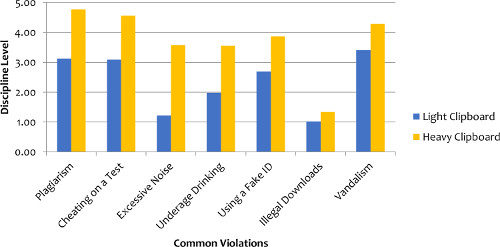操纵一个独立的变量,通过体现
English
Share
Overview
资料来源: 实验室的加里 · 斯基、 戴夫 Strohmetz 和娜塔莉 Ciarocco — — 蒙茅斯大学
在任何实验中,研究者试图操纵参与者在一组,在研究中有不同的想法、 经验或比其他群体的感情。 一些操作是公开的而别人可以非常微妙。化身是侧重于微妙物理经验可以会无意识地影响一个人的思想的理论发展的研究领域。例如如果一个人身体上微笑,它往往导致情绪高涨。那就是,物理的微笑改变一个人的路的感觉就。
这个视频使用两组实验来看是否身体感觉到的重量就会通过更严厉的纪律形式给同学们违反校园政策的更严格的人。
Procedure
Results
The data were collected from 122 participants. Recall that the discipline scale is calculated on the number assigned to each of the levels of discipline (e.g., 1 = verbal warning, etc.). To determine if there were differences between the heavy and light clipboard conditions on discipline levels, we performed a t-test for independent means.
The results indicated that participants who held the heavy clipboard gave stricter levels of discipline for 6 of the 7 violations (Figure 2). The only exception was for illegal downloading of copyrighted material, which did not demonstrate a significant difference between conditions.

Figure 2: Discipline level for common violations by weight condition.
Applications and Summary
This two-group experiment shows how researchers can manipulate participants’ cognition in a subtle way that participants are not aware of through embodiment.
This study replicates and extends previous research on embodiment by Jostman et al., which showed that holding a weighted clipboard made participants think that fair decision-making through listening to students’ opinions was more important.1
Embodiment effects are increasingly popular and have been studied in a variety of contexts. For example, a recent study by Kille et al. in Psychological Science found that participants who sat at a wobbly desk (which the researchers created by sawing two of the legs short) sought romantic relationship partners who were more stable (i.e., reliable and trustworthy).2
References
- Jostmann, N. B., Lakens, D., & Schubert, T. W. Weight as an embodiment of importance. Psychological Science. 20(9), 1169-1174. doi:10.1111/j.1467-9280.2009.02426.x (2009).
- Kille, D. R., Forest, A. L., & Wood, J. V. Tall, dark, and stable: Embodiment motivates mate selection preferences. Psychological Science. 24(1), 112-114. doi:10.1177/0956797612457392 (2013).
Transcript
Embodiment is a growing research area focused on the theory that subtle physical experiences can unconsciously influence a person’s thoughts and feelings.
Embodiment, or embodied cognition, establishes the connection that bodily actions influence the mind, just as the mind influences actions.
For example, if a person manipulates facial muscles to form a smile, the motor action of smiling unintentionally leads to an elevated mood. That is, the physical experience of smiling changes the way a person feels.
This video will demonstrate how to setup and perform an experiment on embodiment, as well as how to analyze and interpret data investigating whether the physical sensation of weight influences thoughts about disciplinary actions for fellow students.
In this two-group experiment, half of the participants are unknowingly handed a standard clipboard, whereas the other half are unsuspectingly given a weighted clipboard.
While holding one of the clipboards, participants are asked to complete a survey regarding their thoughts on an appropriate level of discipline for various campus violations, which include: cheating on a test, underage drinking, excessive noise, and vandalism.
In this case, the dependent variable is the discipline level. There are five possible levels for each violation, ranging from a verbal warning to expulsion.
It is hypothesized that participants in the heavy clipboard condition will give harsher penalties than those handed the normal clipboard. For instance, a participant holding the heavy clipboard might feel that a student who causes excessive noise should be expelled from school.
Thus, the physical action of holding an object influences subsequent decision-making.
To begin the experiment, meet the participant at the lab.
Provide the participant with informed consent, a brief description of the research, a sense of the procedure, an indication of potential risks/benefits, and the right to withdrawal at any time.
Without the participant realizing it, hand them either a normal or heavy clipboard to hold and take 10 sec to look for the proper survey.
After searching for 10 sec, hand the survey to each participant and ask them to provide feedback regarding how students should be disciplined for campus violations.
After participants have completed and returned the survey, debrief them and explain why deception was necessary for the experiment.
To analyze how the action of holding different clipboards influenced disciplinary decisions, average the numbers from the discipline scale by condition and type of violation.
Graph the mean discipline levels and compare the conditions in each of the violations. After applying a t-test for independent means, notice that participants who held the heavy clipboard significantly gave stricter levels of discipline for six of the seven violations.
Now that you are familiar with how experimental psychologists demonstrate embodiment, let’s look at how other researchers manipulate the body to unknowingly influence the mind.
For example, researchers have used embodiment to study interpersonal relationships and mate selection. They found that participants who sat at a wobbly desk to answer questions sought romantic relationship partners who were more stable, reliable, and trustworthy.
In another study, researchers examined how the brain constructs body representations using a rubber hand illusion. Synchronous brushing of the rubber and hidden hand caused the participant to think that the rubber hand was in fact their hand.
By varying the tactile and visual stimuli, researchers determined what information was important to the brain for determining what a body part is.
You’ve just watched JoVE’s introduction to embodiment. Now you should have a good understanding of how to setup and perform an experiment, as well as analyze and assess the results.
Thanks for watching!
